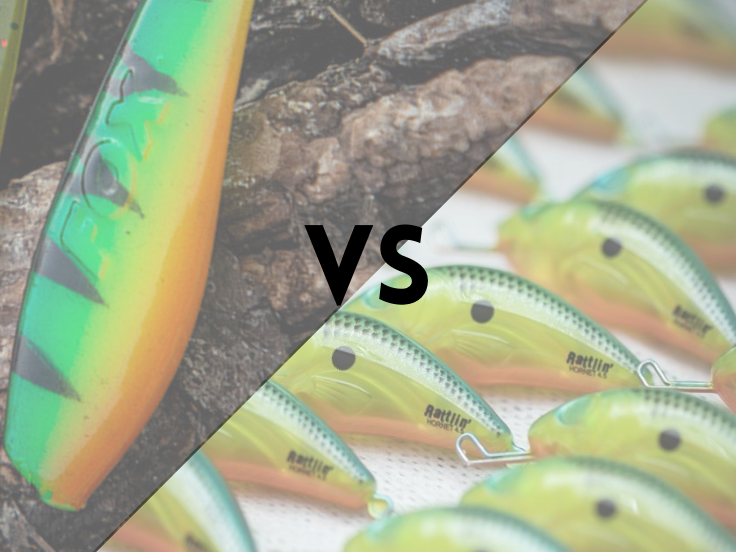
Lure fishing these days regularly sees two different ways of thinking clash. On the one hand, we have anglers who use hard bait and on the other, fans of the animated soft lures available in our collection.
These two types of lure, which are opposed in many ways, nevertheless offer very different arguments depending on the season, the fish you're after or the waters you're fishing in. They're just as effective when you learn to use them at the right time, with the right rod and line.
Hard bait will have the advantage when it comes to the variety of colours. They'll also be at home on the surface or prospecting the seabed at high speed with crankbaits. We could also mention swimbaits or jerkbaits for their redoubled intensity on pike. Our soft bait collection contains thousands of references, so you're bound to find something to suit your needs
On the other hand, soft lures are more economical. They come in a wide range of sizes and are capable of catching all species of fish, from trout to pike-perch and sea bass. They're easy to hide thehook in obstacles and offer a more durable UV colour.
As you will have realised, it's not the bib that makes the difference, it's how you adapt your technique. The best advice you can get is to observe the water and spend some time experimenting. Nevertheless, we're going to give you a few of the broad outlines that characterise the use of one or the other.
The hard bait
The advantages
The first point we'd like to mention is its lifespan. If you don't lose it, it will have a very long life and will only need replacing after a few years. Another point is that it has the enormous advantage of often having a bib that allows it to swim on its own. This means that even the most novice lure angler will be able to catch fish.
Most of the time it will be sold with hooks. It will also be easier to inspect the desired depth. You'll be able to use fishing products on the surface or between two waters, with suspending actions. And, last but not least, the possibilities in terms of colours are endless.
The disadvantages
Hard bait also have aspects that make them difficult to use in certain conditions. For example, they tend to hook more easily into obstacles. You will also be unable to do much of what they were originally designed to do. This means you'll need to have a real collection to cover all uses.
They are also more expensive than the soft ones. This means a significant financial loss when you lose them, and for the same budget, fewer models to fill your boxes. You may also be disappointed by the paints, which can quickly fade. As they are not tinted in the mass, the loss of colour is permanent.
Soft bait
The advantages
There are quite a few advantages. Firstly, the colour, which for most models is tinted in the mass. This ensures a longer lifespan with the same visual qualities.
You can also count on an impressive variety of shapes. You'll find shads, frogs, crayfish and a whole variety of other creatures that our spotlights can shelter.
The price is also an excellent argument. They're easier to design in large numbers and less expensive, which is reflected in the selling price for the buyer. This will make it easier for you to quickly have a complete range and gain in efficiency.
The disadvantages
Here too, there are many aspects to consider. Of course, you'll need to take them into account when making your choice. Failure to do so could make you regret your purchase. The resistance of the rubber is often an argument for turning away from this type of lure. Indeed, when you're looking for pike with materials that are too soft, it can quickly turn into a whole pouch spent during the day.
The quality and variety of shades on offer are less great. Even if there have been clear improvements thanks to technical developments in materials, we're still a long way from the level of finish of hard lures.
Finally, you'll need to be more technical to take advantage of their full potential. A simple linear retrieve will rarely work, and only with certain shapes. You'll need to adapt your choice of rod or line to the need for optimum presentation in front of the predator.
What conclusions can you draw?
In the end, there is no right or wrong choice. Numerous factors can tip the situation in one direction or another. The season, your technical skills and the size of the species you're after are all small things that can have an impact.
It's essential to have both types of lure if you're going to have a chance of coming up with something effective, whatever the situation you're going to encounter. Your sense of animation can make all the difference, and months or even years of practice will go a long way to honing your skills.
Don't forget that each lure has its own specific use. You won't fish for trout with the same shapes, swims or colours as for zander. External factors need to be taken into account as often as possible in order to learn valuable lessons for your future sessions.
And if you still don't catch any fish with all these lures, despite having spent most of your tackle box on them, try one last shot with one of your favourite jerkbaits. You wouldn't believe how much this type of lure has caught over the decades.
Our other articles about soft lures :
